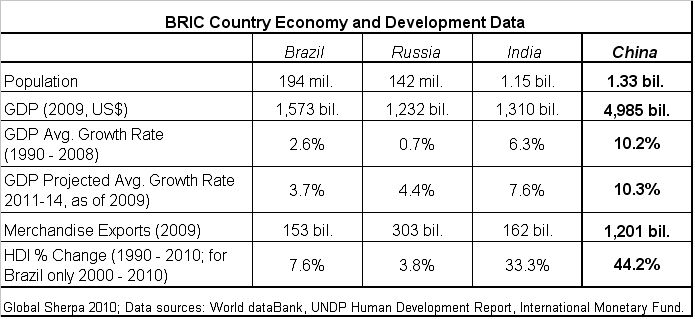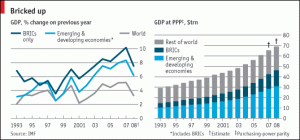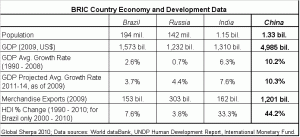China passed Japan to become the world’s second largest economy in 2010 and seems set to overtake the U.S. shortly in historical terms. A vision for the future and diligent planning are two aspects of China’s rapid economic development that don’t always get the attention they might deserve in the daily news headlines.
China and the BRICs
Other developing countries would be emulating China’s success more closely if rapid economic growth and development were merely a matter of low labor costs and a large domestic market. A quick comparison of China’s development performance to that of the other BRIC countries (Brazil, Russia, India) suggests the role of unique factors that distinguish China’s impressive performance.
The term BRIC refers collectively to a group of countries with similar economic development characteristics and was first coined by Jim O’Neil of Goldman Sachs Asset Management in a 2001 paper titled “The World Needs Better Economic BRICs.” Together, the four BRIC countries comprise about 40 percent of the world’s population, cover more than a quarter of the world’s land area over three continents, and account for more than 25 percent of global GDP. China officially invited South Africa to join the group of BRIC nations in 2010. South Korea and Mexico were originally excluded from the BRIC classification by Goldman Sachs on the basis that the two countries were already too much farther along in their economic development than the others.
Some economic data help put the global economic performance of China and the other BRICs in better perspective. From 2000 to 2008, the BRICs share of total world economic output rose from 16 to 22 percent. Together, they accounted for 30 percent of the increase in global output from 2000 to 2008. China alone comprised more than half of the BRIC contribution with rights to greater than 15 percent of the growth in world economic output. The chart below from The Economist shows BRIC GDP growth and share of the world economy relative to other emerging and developing economies and the rest of the world. (Click on the image to view the full-size chart in a separate window or browser tab.)
China Difference
Despite the efforts to link China with the other BRIC countries, the scale of China’s economy and pace of its development stand apart from those of its BRIC peers. The chart below compares key economic and development measures for the BRIC nations, including GDP, merchandise exports, and the UNDP’s Human Development Index (HDI). (Click on the image to see a larger version.)
For more on China’s HDI and development statistics, see the related post Analyzing Global Progress: Interpreting the 2010 UNDP Human Development Report and Index.
So why has China been so successful relative to many of its BRIC and other developing country counterparts in key areas of economic development? A host of influences that are beyond the scope of this article differentiate China’s experience from those of other BRIC and developing nations. Differences in politics, education, regulations, and many other factors all come to bear on each country’s economic performance and prosperity.
In China’s case, a very long and prosperous history also can’t be discounted as a critical component of rapid development and re-emergence on the world stage. While many other countries, including India and Russia, underwent substantial border restructurings in the 20th century, China’s unification dates all the way back to the second century BC. Although China experienced significant political upheaval during its subsequent history, it managed to maintain a position as the world’s leading power for all but about 200 years of the past two millennia. During this time, Chinese civilization gave birth to some of the most influential inventions in world history, including paper, printing, gunpowder, and the compass.
Vision and Planning for Economic Development
In addition to historical capital, another factor in China’s success that often seems to get little attention is the effect of the country’s concerted, coordinated efforts at envisioning and implementing long-term development plans. China’s penchant for planning shows up in a variety of areas, including several recent hot topics in the international news media.
- Natural resource acquisitions – China’s aggressive, worldwide efforts to acquire the rights to natural resources have garnered much media interest. For such a large country, China has surprisingly limited quantities of the natural resources that are so critical to sustaining the country’s future economic growth and performance. To cite just a few noteworthy recent examples, China has invested heavily in Africa and Australia to secure access to mineral rights and in South Asia to stake claim to natural gas fields.
- Rare Earths – China’s newly dominant position in the rare earths market dates to Deng Xiaoping’s 1982 vision that the scarce deposits could someday be to China what oil is to the Middle East. Since the ’80’s, China seems to have set about encouraging the growth of the country’s rare earths industry and knowledge infrastructure. In 1998, the Chinese Ministry of Science and Technology made “Basic research in rare earth materials” the first group of 15 high-priority national research projects. China’s rare earth plans included cultivating a deep pool of scientific and technical experts in the field. Today, there are reportedly at least 6,000 researchers and other experts who focus on rare earth science in China, versus about 20 in the U.S.
- Green energy – China understands the need to develop clean energy sources to compensate for its shortage of natural resources and limit the harmful pollution from rapid industrialization and urbanization that already poses a serious public health problem. Rare earths are a fundamental input to important clean energy technologies and products, including wind turbines. China’s efforts to control and leverage its hold on the rare earths market has partly been aimed at building the country’s position in the green energy industry by driving foreign companies to invest and operate in China.
- Bicycles – China’s leading position in the world bike market dates to Communist efforts to meet the universal desire for three durable goods: a sewing machine, a bicycle and wristwatch. Since 1970, world bike production has outstripped global car output by a factor or more than 2.5 to 1. In 1991, the Chinese government made developing electric bicycles or “e-bikes” an official technology goal. By 2006, there were 2,600 manufacturers of e-bikes in China who were jockeying for position in the rapidly growing domestic and world markets.
Findings and Implications
This article should not be mistaken for an argument on behalf of a government-led economy or highly interventionist industrial policy. Nevertheless, the Chinese experience does point to areas in which it can make good sense to implement some form of over-arching measures to help bring about conditions that are most conducive to successful development and prosperity. In economic terms, there is a place for organizations of some form, be they public or private, to help ward off the economic and development pitfalls that can arise from insufficient access to critical market information and public goods that can result in inadequate investment in the economic infrastructure that undergirds sustainable, long-term economic growth and development.
Related articles and content:
China page – Country Profile, Facts, Latest Live News, and Original Articles
BRICs – Background, Facts, Latest News, and Original Articles
BRICs, Emerging Market Consumer Insights
China and India – Planning vs. Jugaad
World Bike Market, Eco Indicators and Development
Global Science Research and Collaboration
Visit the Global Sherpa home page.
Sources:
Cuddington, David and Elias Schulze. Africa’s Growth Engines: Crisis & Comparison. The Africa Group. May 18, 2009.
Lettieri, Mario and Paolo Raimondi. BRICs Drive Global Economic Recovery. International Monetary Fund. July 22, 2009.
Not Just Straw Men. Economist. June 18, 2009.
The Outline of the Eleventh Five-Year Plan for National Economic & Social Development of the People’s Republic of China. National Development and Reform Commission (NDRC). People’s Republic of China.



